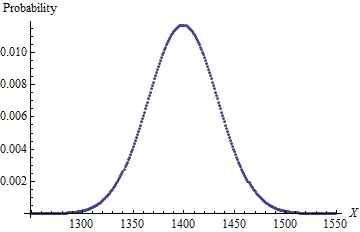First of all I'm not sure where this question should be posted. I'm asking if a statistics problem is NP-Complete and if not to solve it programmatically. I'm posting it here because the statistics problem is the center point.
I'm trying to find a better formula for solving a problem. The problem is: if I have 4d6 (4 ordinary 6 sided dice) and roll them all at once, remove a die with the lowest number (called "dropping"), then sum the remaining 3, what is the probability of each possible result? I know the answer is this:
Sum (Frequency): Probability
3 (1): 0.0007716049
4 (4): 0.0030864198
5 (10): 0.0077160494
6 (21): 0.0162037037
7 (38): 0.0293209877
8 (62): 0.0478395062
9 (91): 0.0702160494
10 (122): 0.0941358025
11 (148): 0.1141975309
12 (167): 0.1288580247
13 (172): 0.1327160494
14 (160): 0.1234567901
15 (131): 0.1010802469
16 (94): 0.0725308642
17 (54): 0.0416666667
18 (21): 0.0162037037
The average is 12.24 and standard deviation is 2.847.
I found the above answer by brute force and don't know how or if there is a formula for it. I suspect this problem is NP-Complete and therefore can only be solved by brute force. It might be possible to get all probabilities of 3d6 (3 normal 6 sided dice) then skew each of them upward. This would be faster than brute force because I have a fast formula when all dice are kept.
I programmed the formula for keeping all dice in college. I had asked my statistics professor about it and he found this page, which he then explained to me. There is a big performance difference between this formula and brute force: 50d6 took 20 seconds but 8d6 drop lowest crashes after 40 seconds (chrome runs out of memory).
Is this problem NP-Complete? If yes please provide a proof, if no please provide a non-brute force formula to solve it.
Note that I don't know much about NP-Complete so I might be thinking of NP, NP-Hard, or something else. The proof for NP-Completeness is useless to me the only reason why I ask for it is to prevent people from guessing. And please bare with me as it's been a long time since I worked on this: I don't remember statistics as well as I might need to solve this.
Ideally I'm looking for a more generic formula for X number of dice with Y sides when N of them are dropped but am starting with something much more simple.
Edit:
I would also prefer the formula to output frequencies but it is acceptable to only output probabilities.
For those interested I have programmed whuber's answer in JavaScript on my GitHub (in this commit only the tests actually use the functions defined).
